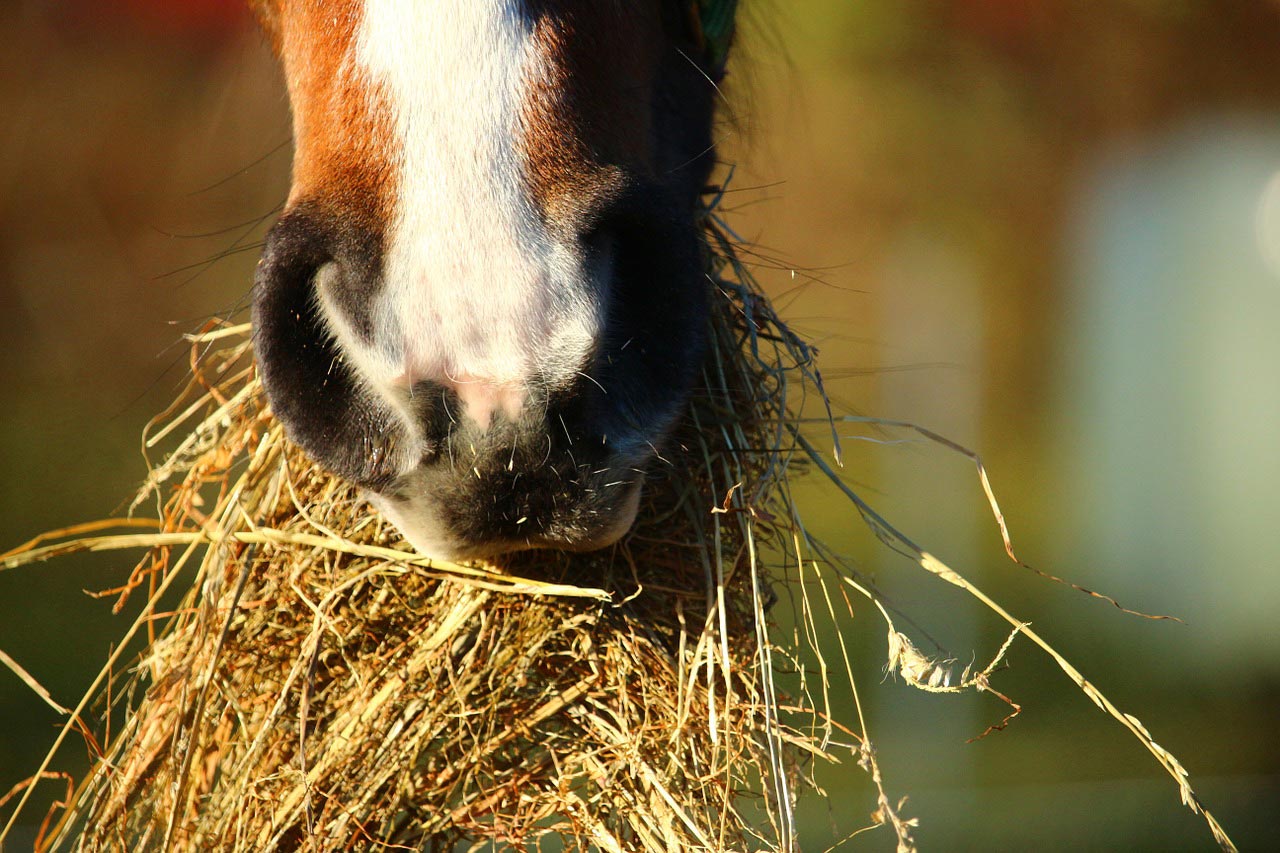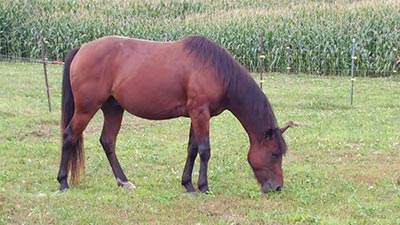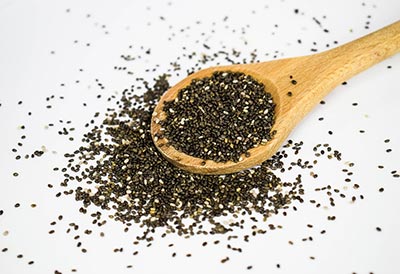
by Juliet M. Getty, Ph.D.
Alfalfa can be an excellent addition to most horses' diets, even for those who are insulin resistant (IR). I often recommend feeding it because it boosts the overall protein quality of a grass-hay diet and, in general, enhances the horse's muscle tone, immune system, and overall health.
But some people just don't want to feed alfalfa; they believe it causes laminitis. And after years of working with horses, it appears that it may, in fact, lead to laminitis in some horses. I found this to be very puzzling since alfalfa is low in sugar and starch, even lower than most grass hays. Its high protein content, however, makes it more caloric, which can be a problem for IR horses who need to lose weight.
But I always included some, albeit a small amount.
Nevertheless, there appears to be something about alfalfa that troubles some IR horses. After giving this considerable thought, I believe I can shed some light on why this may be the case. There are two plausible reasons, both leading to excess blood glucose and the concomitant secretion of insulin:
1. Excess protein in the diet
2. Preservative often sprayed on alfalfa hay
Excess protein - quality vs quantity
All proteins consist of long, branched chains of amino acids. Upon digestion, amino acids are free to enter the blood stream and travel to individual tissues, where they are recombined in a very specific order to produce the protein needed by that particular tissue (e.g., blood, lungs, heart, liver, skin, bones, joints, etc.).
There are 22 amino acids, of which ten are considered essential -- they cannot be produced within the horse's body or they cannot be produced in adequate quantity to meet the horse's need. For a protein to be of high quality, it must contain all of the essential amino acids in proper proportion.
Plant protein sources are potentially limiting in the essential amino acid, lysine. When lysine is low, protein synthesis comes to a halt. The National Research Council (NRC) has established lysine requirements for all horses. As of yet, requirements for the other nine essential amino acids have not been quantified, though recent research has shown that threonine may be the second limiting amino acid.
To ensure your horse has an ample amino acid pool in his bloodstream from which to synthesis proteins within his body, it is best to feed a variety of protein sources to improve the quality while not overdoing the quantity.
Commercially fortified feeds often include a variety of ingredients to create quality protein. If you'd like to do it yourself, table 1 offers suggestions on alternative whole foods that can be incorporated into a grass-based diet.
|
Table 1: Protein Content of Protein-Rich Feedstuffs[i] per 100 grams |
||
|
Feedstuff |
Approximate volume measure equivalent to 100 g |
Protein (grams) |
|
Alfalfa pellets (18% CP) |
1 cup (240 ml) |
21.0 |
|
Almonds (ground) |
1 cup (240 ml) |
21.2 |
|
Beet Pulp |
1 cup (240 ml) |
10.0 |
|
Brewer's Yeast |
1/3 cup + 1T (100 ml) |
53.0 |
|
Chia seeds |
½ cup (120 ml) |
15.6 |
|
Flaxseeds (ground) |
1 cup less 1T (225 ml) |
18.3 |
|
Hempseeds |
10 Tablespoons (150 ml) |
37.0 |
|
Rice bran |
1 cup (240 ml) |
15.5 |
|
Soybean meal[ii] |
1 cup + 3 T (285 ml) |
34.8 |
|
Split peas |
½ cup (120 ml) |
24.6 |
|
Sunflower seeds[iii] |
½ cup (120 ml) |
22.8 |
|
Whey protein isolate |
13.3 Tablespoons (200 ml) |
70.0 |
Protein quantity becomes a problem when the horse is overwhelmed with amino acids. If large amounts of protein are consumed beyond the horse's need to replace and repair body proteins, the excess amino acids cannot be stored for later use. Instead, they are destroyed.
The metabolites of amino acid degradation can potentially lead to excess glucose in the blood.
Here is how it happens: Inside the liver, an amino acid is broken apart into two pieces - an amino group and an organic acid. The amino group quickly becomes ammonia and is converted to urea, which is then excreted from the body in the urine.
The organic acid has several pathways it can take: (1) It can be burned for energy (especially if the diet is not high enough in calories to meet energy needs); (2) It can be converted to body fat (if the diet is too high in calories); or (3) It can be converted to glucose. It's this third path that potentially causes problems for the IR horse.
Once glucose is produced, the pancreas secretes insulin to allow glucose to enter the cells and store body fat. Elevated insulin can create inflammation with the feet and the IR horse is particularly vulnerable because his insulin level is already elevated.
Alfalfa hay can contribute to excess protein
It is easy to overwhelm the horse with too much protein when feeding alfalfa hay because on average, alfalfa has more than twice the amount of protein as grasses. Individual grass and alfalfa hays will vary significantly; therefore it is always best to have your hay analyzed.
It is important to realize that excess protein from any source can lead to excess insulin secretion. Alfalfa hay is generally fed in much larger quantity than adding a whole food such as alfalfa pellets, split peas, or hempseeds (see table 1), making it appear as though it is the alfalfa that is the culprit.

Let's look at a hypothetical example:
Pepper is an adult Quarter Horse. He is overweight - 1200 lbs (550 kg). He's been diagnosed with insulin resistance and has already suffered once from laminitis. He is lightly active.
According to the NRC, his minimum protein requirement is 770 grams per day. Since the overweight, IR horse has much inflammation in his system (both body fat and insulin are highly inflammatory), tissues throughout the body can be damaged. Protein is needed to help repair and maintain tissues.
Consequently, it is reasonable to add to the NRC requirement. Ten percent is a sensible amount to add, bringing the protein requirement up to 847 grams per day.
Pepper's cool-season grass hay has been analyzed to be low in sugar (ESC) and starch and is therefore, appropriate to feed free choice. The crude protein content is 8%. After being allowed to self-regulate through free-choice feeding, his grass hay consumption averages 22 lbs per day.
To boost his protein quality, Pepper's owner adds 5 lbs of alfalfa hay per day, which has been analyzed to contain 20% crude protein.

Protein intake is calculated as follows:
Grass hay: 22 lbs X 454 g/lb X .08 = 799 grams
Alfalfa hay: 5 lbs X 454 g/lb X .20 = 454 grams
Total: 799 + 454 = 1253 grams.
1253 grams significantly exceeds his protein requirement. Pepper's owner decides to remove the alfalfa hay. To offer a variety of protein sources, she replaces the hay with 2 cups alfalfa pellets and 1 cup of split peas:
Now the protein intake looks like this:
Grass hay: 799 grams
Alfalfa pellets: 2 X 21 grams = 42 grams
Split Peas: 2 X 24.6 grams = 49.2 grams
Total: 890.2 grams
Interpretation: The protein content of the first diet is too high because of added alfalfa, which could contribute to elevated insulin secretion. However, alfalfa, in and of itself, is not necessarily the issue.
The issue is too much protein. By removing the alfalfa hay and replacing it with a small amount of alfalfa pellets and split peas, the protein quality is improved while keeping the overall content close to the requirement.
Here's another real issue with alfalfa -- Propionic acid
Alfalfa is often sprayed with buffered propionate (also known as propionic acid) to retard spoilage if baled during wet or humid conditions. This preservative not only reduces mold, but it also decreases drying time in the field, thereby diminishing the potential for leaf loss from harvesting and providing more baling flexibility.
Baling can begin in the humid early morning hours and can continue later into the evening, allowing greater acreage to be harvested.
Not considered to be harmful, propionate is one of three volatile fatty acids (VFA) naturally produced by the hindgut bacteria during hay fermentation. The other two VFAs are acetate and butyrate. These VFAs are a significant energy source for your horse.
Acetate is utilized by many tissues including the heart, muscles, and the brain. Butyrate provides energy for the cells that line the hindgut epithelium. Propionate is a major precursor toward glucose production through a process known as gluconeogenesis. And that's a problem for the IR horse.
Once propionate is absorbed and metabolized, it is converted to glucose! So when you feed alfalfa that has been treated with propionic acid, you are essentially increasing your horse's blood glucose level, just as you would if you had fed a hay with a large amount of sugar and starch. Increased glucose leads to increased insulin. And the rest is - well, you get the picture.
Talk to your alfalfa hay producer. If the hay has been sprayed with propionate, and excess glucose is a concern for your horse, do not feed this hay. In areas of the country where humidity is not an issue, alfalfa is not likely sprayed with propionate. But it is always worth checking.

Bottom line
Too much protein can be problematic for the IR horse and it is easy to exceed the horse's protein requirement when adding alfalfa hay. Alfalfa itself is not the issue, but rather, its contribution to the protein content of the entire diet.
Since protein quality is important, consider adding smaller amounts of alfalfa hay or add different protein sources to better stay within limits. Avoid alfalfa that has been treated with propionic acid.
This article is printed with permission from Juliet M. Getty, Ph.D. at gettyequinenutrition@gmail.com
Find out more about equine nutrition in our Bedding & Feed section, right here on EIE.
[i] Obtained from a variety of sources such as www.feedipedia.org and Nutrient Requirements of Horses, Sixth Revised Edition, 2007.
[ii] Soy may not be appropriate for overweight horses since it appears to have goitrogenic properties in humans, potentially detrimental to the thyroid gland. Ref: Doerge, D.R., 2002. Goitrogenic and estrogenic activity of soy isoflavones. Environmental Health Perspectives, vol. 110.
[iii] When feeding sunflower seeds with the shell, always choose Black Oil Sunflower Seeds; striped ones are too fibrous to be eaten whole. Also keep in mind that sunflower oil is very high in inflammatory omega 6s and should be balanced with a source of omega 3s.

































